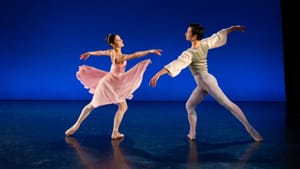Stay in the Loop
BSR publishes on a weekly schedule, with an email newsletter every Wednesday and Thursday morning. There’s no paywall, and subscribing is always free.
Springtime set to music
The Pennsylvania Ballet presents ‘Resilience’

Resilience, the Pennsylvania Ballet’s second outing of the spring season, features four newly filmed pieces that range from the Christopher Wheeldon’s Polyphonia, set to György Ligeti’s experimental music; to artistic director Angel Corella’s recreation of Raymonda Variations drawn from Petipa’s story ballet. My favorite piece of the night, George Balanchine’s Allegro Brilliante, beautifully bridges the centuries. The company has brought these three choreographers together before, in its 2018 Grace and Grandeur. Taken together, the choreographers set dance as a conversation over time with the pull of influence and the push for change.
Lush intensity
Polyphonia is up first. It’s one of Wheeldon’s early experimental works, set on four pairs of dancers in purple leotards by costume designer Holly Hynes and danced to a series of Ligeti’s piano pieces. Each piece explores a different mood, from the frenetic “Désordre” to a waltz from Ligeti’s Musica Ricercota. The dancers are sublime in a technically complex work that requires precise, angular movement. At times, the men seem to be folding the women like origami. Dancers Sterling Baca and Oksana Maslova give us lush intensity in their duets: he turns her in low, twisting lifts that seem effortless. The connection is palpable, but with an edge almost of obsession.
Wheeldon seems to be taking Balanchine’s leotard ballets to the dark side and, ultimately, I couldn’t help feeling that we’re not experiencing just a dance, but an argument across a generation with a choreographer who wasn’t there to see it. Wheeldon was 10 when Balanchine died. He created the piece for Balanchine’s New York City Ballet.
Speed and swoons
If Wheeldon engaged Balanchine, then Balanchine, next in the program, did the same with Allegro Brilliante, giving us the classical style of Petipa’s Mariinsky, in bright, lyrical movement set to the Piano Concerto No. 3 by Peter Ilyich Tchaikovsky. The piece is constructed very much like a wedding scene in a Petipa ballet, with a corps of four couples, the women in floaty knee-length dresses of seafoam green and the men in light gray tights with darker vests. Mayara Piniero, in peach, and Zecheng Liang, with a lighter vest to set him apart, dance the principal roles.
The dance is like springtime set to music, so light the dancers seem to float from step to step, leap to leap with Balanchine’s characteristic speed and sharp, quick footwork. Piniero gives us bravura solo work in a part created to showcase the great Maria Tallchief in the 1950s, but I also loved her swoony drifts into Liang’s arms.
Worth watching again
The Raymonda Variations consists of a selection of short dances from Petipa’s full-length ballet, Raymonda, set to the music of Alexander Glazunov. The selected variations can change from company to company as choreographers choose different dances to present. According to the program notes, Corella chose to recreate pieces primarily from Act III of the ballet, the marriage of Raymonda. With this choice, the influence becomes explicit. Balanchine was six when Petipa died. Three years later, he was a student at the school of the Imperial Russian Ballet, where Petipa spent half a lifetime.
The hosting Performance Garage becomes a castle, with standing, many-branched candelabra, chairs for the wedding guests to watch the solos, and smudged stonelike walls. The women wear pancake tutus in yellow or green. Dayesi Torrienti, as the princess, wears white with gold embellishment.
My favorite part comes in the Grand Pas Classique Hongrois. In a sequence of slow lifts, the male dancers lift the female dancers to their shoulders, take slow steps, and lift again, while the women slowly change positions. The sequence ends with the corps in bows and deep curtsies while Torrienti sits aloft on Arian Molina Soca’s shoulder, her arm at a jaunty angle to represent the Hungarian motifs in the music. It is some of the most beautiful music in the ballet, and with the exception of one unfortunate break in a lift that glitched an otherwise excellent performance, it was mesmerizing and I find myself once again glad that my ticket lets me watch over and over.
Technique and personality
If the May series has a thread of lineage from choreographer to choreographer, the spring season has had a separate thread running from series to series—short solos by Jermel Johnson. This time, he dances to And so it is... from choreographer Dwight Rhoden, cofounder of Complexions Contemporary Dance, and set to the music of Steve Reich. The piece, created for competitions, shows off Johnson’s technique, as well as his personality.
Image description: Ballet dancers Mayara Piniero and Zecheng Liang perform Balanchine’s Allegro Brilliante. Piniero wears a knee-length peach-colored dress and Liang wears shades of gray. They face each other, arms outstretched, each with one leg pointed behind.
What, When, Where
The Pennsylvania Ballet presents Resilience, performed at the Performance Garage and streamed from April 29 through May 5, 2021. Find tickets ($25) at paballet.org.
Sign up for our newsletter
All of the week's new articles, all in one place. Sign up for the free weekly BSR newsletters, and don't miss a conversation.

 Camille Bacon-Smith
Camille Bacon-Smith